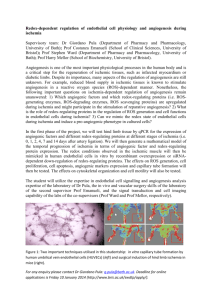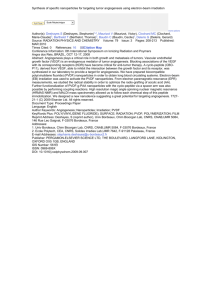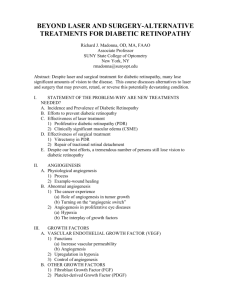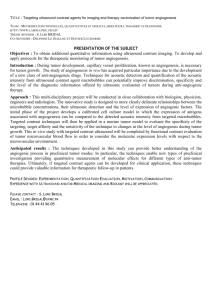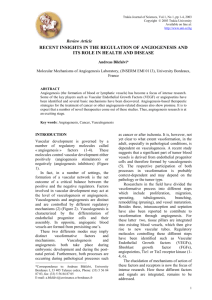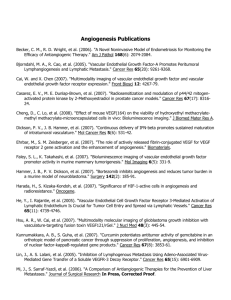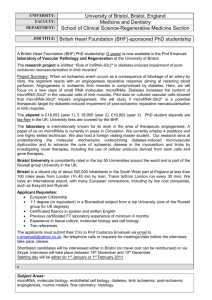II. Angiogenesis - Engineering Computing Facility
advertisement
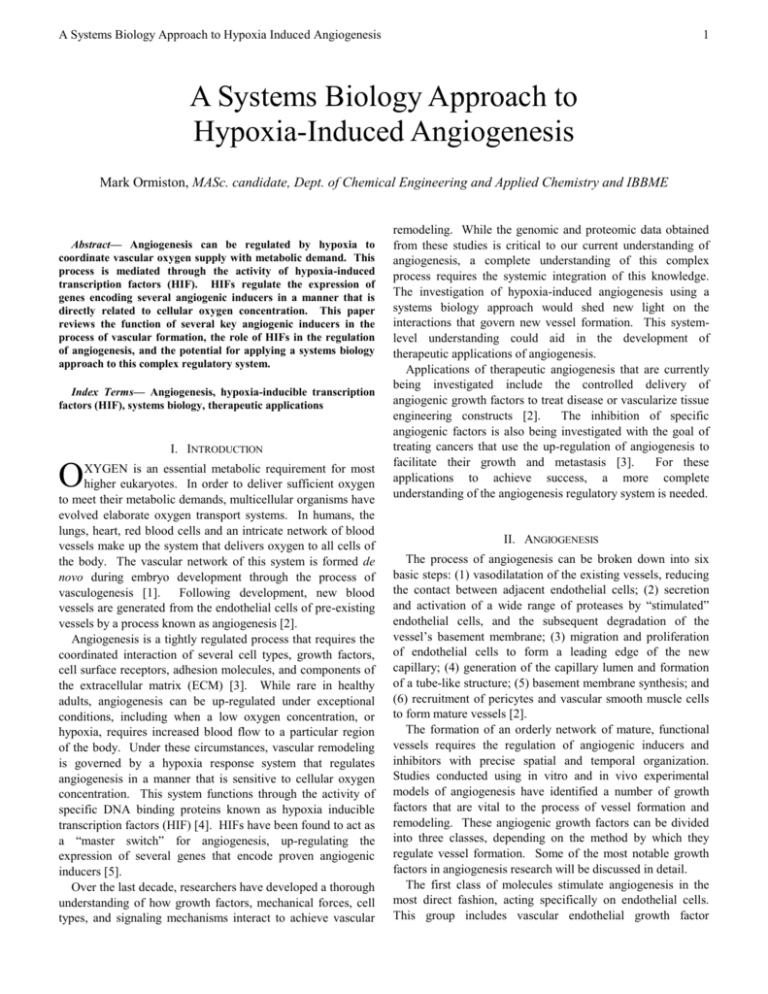
A Systems Biology Approach to Hypoxia Induced Angiogenesis 1 A Systems Biology Approach to Hypoxia-Induced Angiogenesis Mark Ormiston, MASc. candidate, Dept. of Chemical Engineering and Applied Chemistry and IBBME Abstract— Angiogenesis can be regulated by hypoxia to coordinate vascular oxygen supply with metabolic demand. This process is mediated through the activity of hypoxia-induced transcription factors (HIF). HIFs regulate the expression of genes encoding several angiogenic inducers in a manner that is directly related to cellular oxygen concentration. This paper reviews the function of several key angiogenic inducers in the process of vascular formation, the role of HIFs in the regulation of angiogenesis, and the potential for applying a systems biology approach to this complex regulatory system. Index Terms— Angiogenesis, hypoxia-inducible transcription factors (HIF), systems biology, therapeutic applications I. INTRODUCTION O XYGEN is an essential metabolic requirement for most higher eukaryotes. In order to deliver sufficient oxygen to meet their metabolic demands, multicellular organisms have evolved elaborate oxygen transport systems. In humans, the lungs, heart, red blood cells and an intricate network of blood vessels make up the system that delivers oxygen to all cells of the body. The vascular network of this system is formed de novo during embryo development through the process of vasculogenesis [1]. Following development, new blood vessels are generated from the endothelial cells of pre-existing vessels by a process known as angiogenesis [2]. Angiogenesis is a tightly regulated process that requires the coordinated interaction of several cell types, growth factors, cell surface receptors, adhesion molecules, and components of the extracellular matrix (ECM) [3]. While rare in healthy adults, angiogenesis can be up-regulated under exceptional conditions, including when a low oxygen concentration, or hypoxia, requires increased blood flow to a particular region of the body. Under these circumstances, vascular remodeling is governed by a hypoxia response system that regulates angiogenesis in a manner that is sensitive to cellular oxygen concentration. This system functions through the activity of specific DNA binding proteins known as hypoxia inducible transcription factors (HIF) [4]. HIFs have been found to act as a “master switch” for angiogenesis, up-regulating the expression of several genes that encode proven angiogenic inducers [5]. Over the last decade, researchers have developed a thorough understanding of how growth factors, mechanical forces, cell types, and signaling mechanisms interact to achieve vascular remodeling. While the genomic and proteomic data obtained from these studies is critical to our current understanding of angiogenesis, a complete understanding of this complex process requires the systemic integration of this knowledge. The investigation of hypoxia-induced angiogenesis using a systems biology approach would shed new light on the interactions that govern new vessel formation. This systemlevel understanding could aid in the development of therapeutic applications of angiogenesis. Applications of therapeutic angiogenesis that are currently being investigated include the controlled delivery of angiogenic growth factors to treat disease or vascularize tissue engineering constructs [2]. The inhibition of specific angiogenic factors is also being investigated with the goal of treating cancers that use the up-regulation of angiogenesis to facilitate their growth and metastasis [3]. For these applications to achieve success, a more complete understanding of the angiogenesis regulatory system is needed. II. ANGIOGENESIS The process of angiogenesis can be broken down into six basic steps: (1) vasodilatation of the existing vessels, reducing the contact between adjacent endothelial cells; (2) secretion and activation of a wide range of proteases by “stimulated” endothelial cells, and the subsequent degradation of the vessel’s basement membrane; (3) migration and proliferation of endothelial cells to form a leading edge of the new capillary; (4) generation of the capillary lumen and formation of a tube-like structure; (5) basement membrane synthesis; and (6) recruitment of pericytes and vascular smooth muscle cells to form mature vessels [2]. The formation of an orderly network of mature, functional vessels requires the regulation of angiogenic inducers and inhibitors with precise spatial and temporal organization. Studies conducted using in vitro and in vivo experimental models of angiogenesis have identified a number of growth factors that are vital to the process of vessel formation and remodeling. These angiogenic growth factors can be divided into three classes, depending on the method by which they regulate vessel formation. Some of the most notable growth factors in angiogenesis research will be discussed in detail. The first class of molecules stimulate angiogenesis in the most direct fashion, acting specifically on endothelial cells. This group includes vascular endothelial growth factor A Systems Biology Approach to Hypoxia Induced Angiogenesis (VEGF) and the angiopoietins (Ang1 and Ang2). VEGF is secreted by many cell types. In vitro, it has been proven to stimulate ECM degradation [6], as well as the proliferation, migration, and tube formation of endothelial cells [7]. It also induces the expression of a number of proteases by endothelial cells. These proteases are essential for the degradation of the ECM and basement membrane [6]. In vivo, VEGF has been found to mediate microvessel permeability, which is an important step in the initiation of angiogenesis [8]. Angiopoietins have been found to play a complementary role to VEGF, regulating new vessel stabilization and maturation [9]. The second class of angiogenic inducers, which includes members of the fibroblast growth factor (FGF) family of cytokines, stimulates angiogenesis by activating a broad range of target cells [3]. FGFs accumulate in the ECM of tissues, and can be released during the degradation of the ECM surrounding stimulated vessels. The most notable of the FGFs, basic fibroblast growth factor (bFGF), can induce the expression of proteases by endothelial cells [10], as well as endothelial cell migration and proliferation [11]. bFGF is also produced by endothelial cells to recruit pericytes and smooth muscle cells [12]. The third group of angiogenic inducers play more indirect roles in vascular remodeling. This group includes platelet derived growth factor (PDGF) and transforming growth factor beta (TGF-). When secreted by endothelial cells, PDGF serves as a mitogen for smooth muscle cells [13] and increases their expression of VEGF [14]. Endothelial cell secreted PDGF has also been linked to the recruitment of pericytes [12]. TGF- induces angiogenesis by up-regulating the expression of PDGF in endothelial cells, as well as bFGF [11], and VEGF in smooth muscle cells [15]. 2 regulation [5]. Hypoxia inducible transcription factors are -heterodimers. Both the HIF- and HIF- subunits have several isoforms encoded by distinct genetic loci [5]. While HIF- subunits are constitutive nuclear proteins that can also dimerize with transcription factors other than HIF-, HIF- subunits are apparently dedicated to hypoxia response [17]. Of the three murine HIF- isoforms that have been identified, HIF-1 and HIF-2 are the most closely related. These isoforms are both able to up-regulate hypoxia responsive transcriptional activity through the binding of HREs [18]. In oxygenated cells, HIF- proteins are inactivated by two independent mechanisms: rapid proteolytic destruction and inhibition of transcriptional activity [5]. These regulatory mechanisms, which prevent the up-regulation of angiogenic genes under normal oxygen conditions, are controlled through the action of two types of HIF hydroxylases. Figure 1 outlines the function of both HIF hydroxylase types. The first set of these enzymes, the HIF prolyl hydroxylases, can hydroxylize HIF- proteins at evolutionarily conserved prolyl residues (two prolyl residues, Pro402 and Pro564, in the human orthologue of HIF-1). Hydroxylization of these prolyl residues increases the affinity of HIF- for proteasomal destruction via the von Hippel-Lindau (VHL) E3 ubiquitin ligase complex [19]. Once hydroxylized, either of the two prolyl sites can interact independently with VHL E3, resulting in rapid degradation [20]. The second set of HIF hydroxylases are HIF asparaginyl hydroxylases. These enzymes, termed III. REGULATION OF ANGIOGENESIS BY HYPOXIA The role of hypoxia as a regulator of angiogenesis is illustrated by the large number of genes involved in angiogenesis that are responsive to hypoxia in tissue culture. Examples include genes for angiogenic growth factors such as VEGF, angiopoietins, and FGFs, as well as the genes encoding their various receptors [5]. For a substantial number of these genes, the hypoxic response can be linked directly to HIF activity. HIFs regulate the transcription of hypoxia-inducible genes through the binding of hypoxia response elements (HRE) in their promoter and enhancer regions [16]. HREs have been identified in genes associated with a variety of cellular and systemic responses to hypoxia, including erythropoiesis, vasodilatation, glycolysis, and angiogenesis [16]. HREs have been isolated on the promoter regions of genes encoding VEGF, the VEGF receptor Flt-1, nitric oxide synthases (associated with vasodilatation), and some proteases [5]. The expression of genes for angiogenic factors such as angiopoietins, FGFs, and PDGF may also be indirectly affected by HIFs through secondary cascades of gene Fig. 1. Dual regulation of HIF- subunits by HIF hydroxylases [5]. A Systems Biology Approach to Hypoxia Induced Angiogenesis FIH (factor inhibiting HIF), inhibit HIF transcriptional activity through the -hydroxylation of an asparaginyl residue in the Cterminal activation domain of HIF- (Asn803 in human HIF1). Hydroxylation of this residue blocks the interaction of HIF- with the transcriptional activator p300 [21]. The function of both groups of HIF hydroxylases can be directly correlated to cellular O2 concentration. Both enzymes hydroxylize amino acids through the cleavage of molecular oxygen [22]. Under hypoxic conditions, the absence of molecular oxygen results in decreased HIF hydroxylase activity and the increased expression of genes encoding angiogenic inducers. As illustrated in figure 2, this system couples angiogenic regulation to metabolic oxygen demand through a pathway that links O2 availability, HIF hydroxylase activity, HIF-dependent transcription and angiogenic growth factor expression [5]. It is important to note that hypoxia also influences transcriptional pathways other than the HIF pathway [5]. The interaction of these pathways with HIF and HIF hydroxylases would greatly increase the complexity of the pathway outlined in figure 2. The interaction of other pathways with elements of the HIF pathway is the subject of active research. The pathway outlined in figure 2 could be modeled using a systems biology approach. Recent advances in computational biology and systems biology have provided tools capable of organizing the vast amounts of genomic and proteomic data associated with the various elements of this regulatory system. This data could be used to create a model of the regulatory control pathways that link different elements of the system in order to study the dynamic interactions associated with hypoxia-induced angiogenesis [23]. This type of research would be useful in the development of new therapeutic angiogenesis strategies that capitalize on HIF as a “master switch” for angiogenic gene expression. IV. THERAPEUTIC APPLICATIONS OF ANGIOGENESIS Advances in our understanding of vascular remodeling have prompted attempts by researchers to manipulate angiogenesis for therapeutic applications. These applications include the targeted delivery of angiogenic growth factors such as VEGF or bFGF to treat disease states like ischemia [24] and coronary artery disease [25]. Controlled growth factor delivery has also been investigated as a means of vascularizing tissue engineering constructs [26]. Early applications, based on the delivery of a single growth factor (often VEGF or bFGF) to stimulate vessel remodeling achieved minimal success. The newly formed vessels were often leaky, immature and disorganized [27]. Many applications using VEGF or bFGF delivery exclusively also resulted in edema from nonfunctional vessel formation [27]. These results are not surprising considering the therapies were attempting to use a single growth factor to regulate a process that requires the regulated interaction of several angiogenic inducers and inhibitors. 3 Fig. 1. Pathway linking angiogenesis to oxygen availability through the regulation of HIF [5]. Recently, investigations of pro-angiogenic applications have adopted more system-based strategies. Modern tissue engineering scaffolds are designed to induce functional vessel formation through the sequential delivery of complementary growth factors such as VEGF and Ang1 [27,28]. These scaffolds produce more mature, organized vessels that are surrounded by pericytes [28]. Researchers have also designed successful therapy strategies that make use of the system that governs hypoxia-induced angiogenesis. A more stable version of HIF-1 can be created through the deletion of one of the prolyl residues that is sensitive to hydroxylation by prolyl hydroxylases. The transgenic expression of this molecule in the skin of mice resulted in marked activation of HIF transcriptional targets and a significant increase in blood vessel growth. The vessels appeared functional, and showed no signs of the edema often associated with VEGF therapy [29]. Successful strategies have also been designed that induce angiogenesis through the inhibition of HIF hydroxylases, as well as the blocking of the VHL E3 complex [5]. Our increased understanding of angiogenesis can also be applied to the inhibition of angiogenic factors associated with tumor growth and metastasis. Tumors often up-regulate angiogenic growth factors in order to grow beyond the size limits imposed by oxygen diffusion [3]. Among these factors, VEGF, bFGF, and the angiopoietins play a predominant role [30]. Several anti-angiogenic cancer therapies are currently in clinical trials. These therapies are based on strategies that (1) interfere with angiogenic ligands, their receptors or downstream signaling; (2) up-regulate or deliver endogenous inhibitors; or (3) directly target tumor vasculature [30]. A major problem with these therapies is that they often only target one angiogenic inducer. As tumors grow, they produce A Systems Biology Approach to Hypoxia Induced Angiogenesis an increasing assortment of angiogenic growth factors. This means that if the therapy only works to block one factors (eg. VEGF), tumors may switch to another factor (eg. bFGF) and continue growing [30]. In concordance with their physiological role, HIFs have also been identified as important factors in tumor angiogenesis. Up-regulation of HIF is observed in many common cancers. This up-regulation can have several causes, including hypoxia in the region of the tumor, stimulation by particular growth factors, and tumor suppressor mutations. The most notable of these tumor suppressor mutations occurs in the VHL complex, which has been identified as a key component of the HIF regulatory system [5]. The identification of HIF as a key player in tumor angiogenesis has also made it an important anticancer target. There is little doubt that an improved system-level understanding the HIF regulatory system will be helpful in the development of new therapies that target HIF activity the for treatment of cancer. V. CONCLUSION The importance of a systems biology approach to the study of hypoxia-induced angiogenesis is illustrated by the wealth of new therapies that are being developed using elements of the regulation HIF pathway. As the interactions of angiogenic system elements become more clearly defined, and representative models are created to test new theories, the importance of a system-level understanding of angiogenesis will become even more evident. REFERENCES [1] [2] [3] [4] [5] [6] [7] [8] [9] E. M. Conway, D. Collen, and P. Carmeliet, “Molecular mechanisms of blood vessel growth,” Cardiovascular Research, vol. 49, pp. 507-521, 2001. M. Nomi, A. Atala, P. De Coppi, S. Soker, “Principals of neovascularization for tissue engineering,” Molecular Aspects of Medicine, vol. 23, pp. 463-483, 2002. S. Liekens, E. De Clercq, J. Neyts, “Angiogenesis: regulators and clinical applications,” Biochemical Pharmacology, vol. 61, pp. 253270, 2001. G. L. Semenza, “Regulation of mammalian O2 homeostasis by hypoxiainducible factor 1,” Annu. Rev. Cell Dev. Biol., vol. 15, pp. 551-578, 1999. C. W. Pugh and P. J. Ratcliffe, “Regulation of angiogenesis by hypoxia: role of the HIF system,” Nature Medicine, vol. 9, no. 6, pp. 677-684, June 2003. E. N. Unemori, N. Ferrara, E. A. Bauer, and E. P. Amento, “Vascular endothelial growth factor induces interstitial collagenase expression in human endothelial cells,” J Cell Physiol., vol.153, pp. 557-562, 1992. M. S. Pepper, N. Ferrara, L. Orci, and R. Montesano, “Potent synergism between vascular endothelial growth factor and basic fibroblast growth factor in the induction of angiogenesis in vitro,” Biochem. Biophys. Res. Commun., vol. 189, pp. 824-831, 1992. H. F. Dvorak, L. F. Brown, M. Demtar, and A. M. Dvorak, “Vascular permeability factor/vascular endothelial growth factor, microvascular hyperpermeability, and angiogenesis,” Am. J. Pathol., vol. 146, pp. 1029-1039, 1995. J. Holash, S. J. Wiegand, and G. D. Yancopolous, “New model of tumor angiogenesis: dynamic balance between vessel regression and growth mediated by angiopoietins and VEGF,” Oncogene, vol. 18, pp. 53565362, 1999. 4 [10] J. A. Ware and M. Simons, “Angiogenesis in ischemic heart disease,” Nature Medicine, vol. 3, p. 158, 1997. [11] R. Flaumenhaft, M. Abe, P. Mignatti, and D. B. Rifkin, “Basic fibroblast growth factor-induced activation of latent transforming growth factor b in endothelial cells: Regulation of plasminogen activator activity,” J. Cell Biol., vol. 118, p. 901, 1992. [12] K. K. Hirschi and P. A. D’Amore, “Pericytes in the microvasculature,” Cardiovasc. Res., vol. 32, pp. 687, 1996. [13] S. Banai, M. T. Jaklitsch, M. Shou, D. F. Lazarous, M. Scheinowitz, S. Biro, S. E. Epstein, and E. F. Unger, “Angiogenic-induced enhancement of collateral blood flow to ischemic myocardiumby vascular endothelial growth factoring dogs,” Circulation, vol. 89, p. 2183, 1994. [14] D. L. Goad, J. Rubin, H. Wang, A. H. Tashjan, and C. Patterson, “Enhanced expression of vascular endothelial growth factoring human SaOS-2 osteoblast-like cells and murine osteoblasts induced by insulinlike growth factor I,” Endocrinology, vol. 137, pp. 2262, 1996. [15] G. W. Cockerill, J. R. Gamble, and M. A. Vadas, “Angiogenesis: Models and modulators,” Int. Rev. Cytol., vol. 159, p. 113, 1995. [16] H. Kimura, A. Weisz, T. Ogura, Y. Hitomi, Y. Kurashima, K. Hashimoto, F. D’Acquisto, M. Makuuchi, and H. Esumi, “Identification of hypoxia-inducible factor 1 ancillary sequence and its function in vascular endothelial growth factor gene induction by hypoxia and nitric oxide,” The Journal of Biological Chemistry, vol. 276, no. 3, pp22922298, Jan. 2001. [17] C. Shen and J. Powell-Coffman, “Genetic analysis of hypoxia signalling and response in C. elegans,” Ann. N.Y. Acad. Sci., vol. 995, pp. 191199, 2003. [18] M. S. Wiesner, “Induction of endothelial PAS domain protein-1 by hypoxia: characterization and comparison with hypoxia-inducible factor-1a,” Blood, vol. 92, pp. 2260-2268, 1992. [19] M. Ivan, “HIFa targeted for VHL mediated destruction by praline hydroxylation: implications for O2 sensing,” Science, vol. 292, pp. 464468, 2001. [20] N. Masson, C. William, P. H. Maxwell, C. W. Pugh, and P. J. Ratcliffe, “Independent function of two destruction domains in hypoxia inducible factor-a chains activatedby prolyl hydroxylation,” EMBO J., vol. 20, pp. 5197-5206, 2001. [21] P. C. Mahon, K. Hirota, and G. L. Semenza, “FIH-1: a novel protein that interacts with HIF-1a and VHL to mediate repression of HIF-1 transcriptional activity. Genes Dev., vol 15, pp. 2675-2686, 2001. [22] C. J. Schofield and Z. Zhang, “Structural and mechanistic studies on 2oxoglutarate-dependent oxygenases and related enzymes,” Curr Opin. Struct. Biol., vol. 9, pp. 722-731, 1999. [23] K. K. Hirshi, T. C. Skalak, S. M. Peirce, and C. D. Little, “Vascular assembly in natural and engineered tissues,” Ann. N.Y. Acad. Sci., vol. 961, pp. 223-242, 2002. [24] Takeshita, L. P. Zheng, E. Brogi, M. Kearney, L. Q. Pu, S. Bunting, N. Ferrara, J. M. Isner and T. Asahara, “Therapeutic angiogenesis, A single intraarterial bolus of vascular endothelial growth factor augments revascularization in a rabbit ischemic hinf limb model,” J. Clin. Invest., vol. 93, pp. 662-670, 1994. [25] D. F. Lazarous, M. Shou, M. Scheinowitz, E. Hodge, V. Thirumurti, A. N. Kitsiou, J. A. Stiber, A. D. Lobo, S. Hunsberger, E. Guetta, S. E. Epstein, and E. F. Unger, “Comparative effects of basic fibroblast growth factor and vascular endothelial growth factor on coronary development and the arterial response to injury,” Circulation. Vol. 94, pp. 1074, 1996. [26] E. R. Edelman, E. Mathiowitz, R. Langer, and M. Klagsbrun, “Controlled and modulated release of basic fibroblast growth factor,” Biomaterials, vol. 12, pp. 619-626, 1991. [27] G. D. Yancopolous, S. Davis, N. W. Gale, J. S. Rudge, S. J. Wiegand, and J. Holash, “Vascular-specific growth factors and blood vessel formation,” Nature, vol. 407, pp. 242-248, Sept. 2003. [28] A. B. Ennett and D.J. Mooney, “Tissue engineering strategies for in vivo neovascularisation,” Expert Opin Biol Ther., vol. 2, no. 8, pp. 805818, Dec. 2002 [29] D. A. Elson, “Introduction of hypervascularity without leakageor inflammation in transgenic mice overexpressing hypoxia inducible factor-1a,” Genes Dev., vol. 15, 2520, 2532, 2001. [30] P. Carmeliet and R. K. Jain, “Angiogenesis in cancer and other diseases,” Nature, vol. 407, pp. 249-257, Sept. 2000. A Systems Biology Approach to Hypoxia Induced Angiogenesis 5
